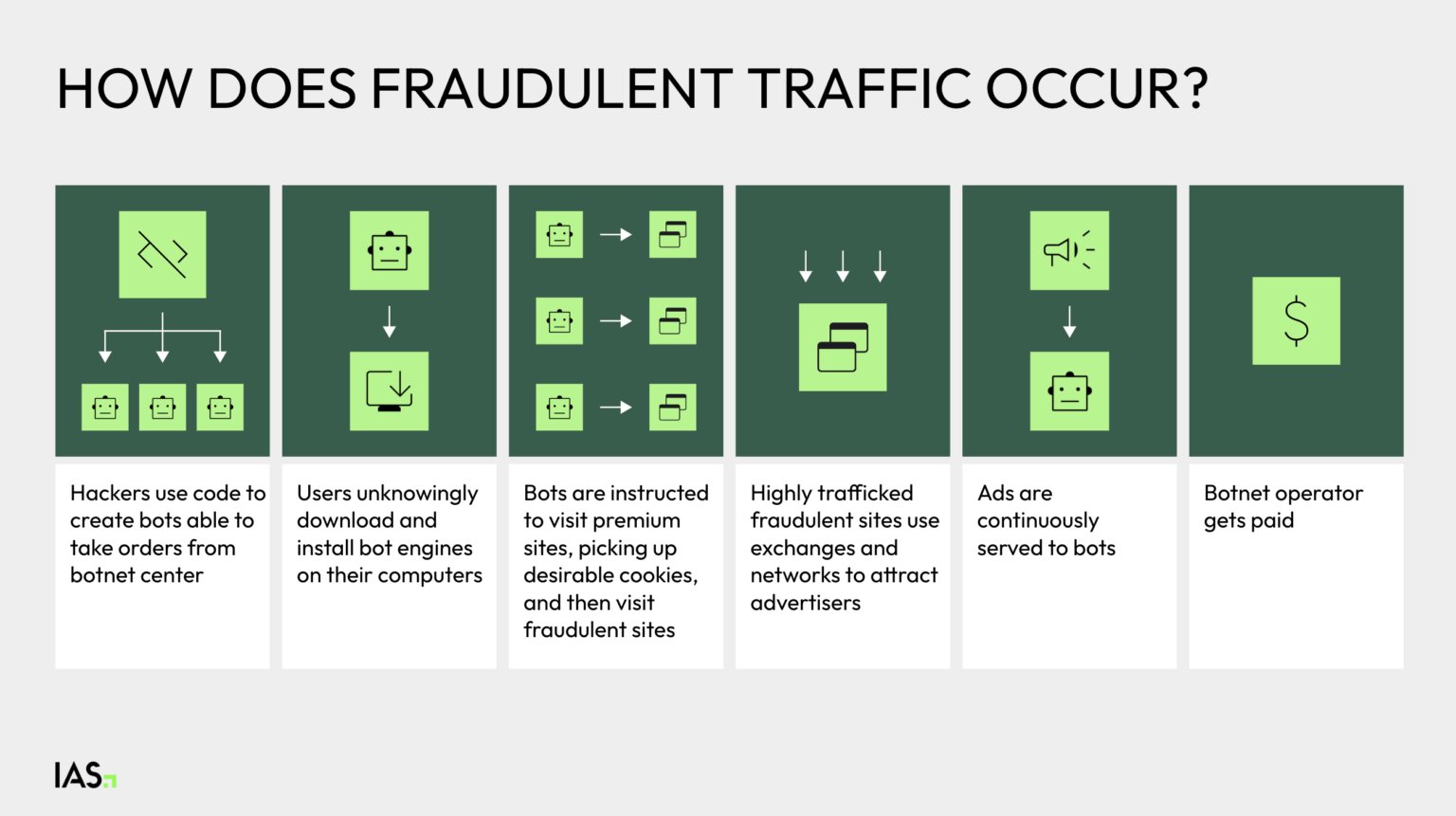Step-by-step look at how fraud infiltrates advertising campaigns
Ad fraud is the deliberate activity that prevents the proper delivery of ads to the right people at the right time, in the right place. Most often, ad fraud refers to certain kinds of traffic, not to publishers or ad tech partners that are a part of the supply chain. So, how does this traffic happen? Here’s a quick snapshot.

Why is fake traffic so harmful?
Fake traffic is a serious threat to digital advertising, undermining the efficacy and integrity of marketing efforts across various platforms.
Each month, sophisticated systems process and analyze trillions of data events to identify anomalies that suggest fraudulent activity. These insights help create robust detection models that differentiate genuine human behavior from bot activity, even in previously uncharted areas.
By analyzing browser sessions and device signals, advanced detection systems can map out the unique characteristics of bots. Recognizing these fraudulent activities is crucial for several reasons.
Protecting your budget
Fake traffic leads to substantial financial losses. Without effective fraud prevention, advertisers risk wasting a significant portion of their budget on ads that never reach real viewers. The World Federation of Advertisers estimates that $50 billion will be lost annually to ad fraud by 2025.
Ensuring campaign integrity
When bots inflate your metrics, it becomes challenging to assess your campaigns’ true performance. Accurate data is essential for making informed decisions and achieving desired results.
Advanced technologies, such as those offered by IAS, detect 90.8% more bot traffic than some leading competitors, ensuring your data remains reliable.
Maintaining effective reach
Fraud mitigation is essential to ensure your ads reach real users. Campaigns that lack proper fraud prevention tools can see fraud levels spike up to 11 times higher, severely compromising your ability to connect with a genuine audience.
Other parties affected by fraudulent traffic
Ad fraud doesn’t just harm advertisers; it also takes a toll on digital media. For many online publishers, advertising is crucial for revenue, as subscriptions are less common.
When ad fraud suppresses ad values, it directly impacts online media earnings.
Consequently, even respected publishers find themselves allocating more web space to ads to offset these losses. This dynamic not only deceives advertisers but also disrupts the financial stability of digital media reliant on ad revenue by triggering:
- Financial Losses: Nothing will drain your ad budget more than fake followers and engagement. Marketers need to be cautious about services claiming they can “boost” any part of their marketing strategies using any sort of bot traffic.
- Decreased ROI: As a result of financial losses, fake traffic will eventually eat into your company’s ROI because, remember, bots don’t buy.
- Misleading Analytics: Fraudulent traffic distorts analytics and data, resulting in inaccurate insights and decision-making. This misinformation can damage a brand’s reputation and hinder its ability to generate leads effectively.
- Damaged Reputation: Social media fraud can tarnish a business’s reputation by fabricating a false sense of popularity or positive sentiment on social platforms. This deceptive practice can sow negative customer perceptions and undermine trust in the brand over time.
- Legal Issues: Manipulative practices on social media platforms can breach their terms of service or lead to legal repercussions, posing significant costs and time commitments for businesses involved.
What counts as invalid traffic?
Invalid traffic (IVT) includes any clicks or impressions that artificially inflate an advertiser’s costs or a publisher’s earnings. This can occur through various methods, including:
- Bot Traffic: Automated software designed to mimic human behavior, generating fake impressions and clicks.
- Click Farms: Groups of low-paid workers manually click on ads to boost engagement metrics deceitfully.
- Ad Stacking: Placing multiple ads on top of each other in a single ad slot. Only the top ad is visible, but impressions are counted for all.
- Pixel Stuffing: Shrinking ads to a nearly invisible size (e.g., 1×1 pixel) so they load without being seen, falsely increasing impression counts.
- Domain Spoofing: Misrepresenting a low-quality site as high-quality to attract higher ad spend.
- Geo Masking: Falsifying geographic data to trick advertisers into believing their ads are reaching a desired location.
Identifying these types of invalid traffic is crucial in preventing ad fraud. Marketers need to be attentive and employ measures to detect and filter out such fraudulent activities.
How to calculate invalid traffic
Calculating invalid traffic involves a series of steps using both technological tools and analytical techniques.
Here’s a straightforward approach to help marketers quantify and address fake traffic:
- Use Advanced Analytics Tools: Implement sophisticated analytics platforms that can identify unusual patterns, such as spikes in traffic from a single IP address or an unusually high click-through rate.
- Monitor Traffic Quality: Regularly review traffic sources and user behavior metrics. Look for inconsistencies like high bounce rates, short session durations, and low engagement rates, which could indicate fake traffic.
- Employ Third-Party Verification Services: Work with third-party verification companies that specialize in detecting ad fraud. These services use algorithms and machine learning to identify and block invalid traffic in real time.
- Conduct Manual Audits: Periodically perform manual audits of your traffic sources and ad placements. Check for discrepancies between reported metrics and observed user interactions.
- Set Up Filters and Blacklists: Configure your ad platforms to filter out known sources of invalid traffic. Maintain and update blacklists of IP addresses and domains associated with fraudulent activity.
Ultimately, deploying the right ad fraud solutions will be your best bet at tackling fake traffic.
Stay ahead of fraudulent traffic
IAS ensures your ads reach real people on legitimate publishers, protecting your media budget.
Additionally, our comprehensive Ad Fraud Essentials Guide covers CTV and video, mobile and in-app, programmatic, and proprietary platforms. It uses a balanced, multi-layered approach and the expertise of our Threat Lab to detect and prevent fraud.
Download our Ad Fraud Essentials Guide now to safeguard your ad spend and stay ahead of the competition with IAS’s innovative, results-driven solutions. If you have any questions, please don’t hesitate to contact us.
 Share on LinkedIn
Share on LinkedIn Share on X
Share on X

